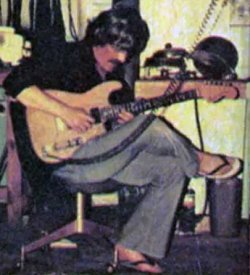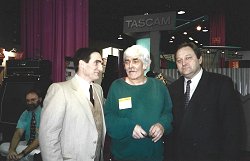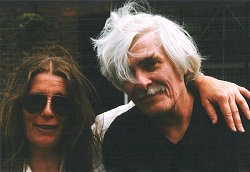
By 1971 and still with no form of compensation for his ideas and design work on the SVT or other V series amplifiers, Dan felt that he
'had enough', and decided that it was time to break his ties with Ampeg, and left that year, refusing to renew his acrylic guitar and bass
contracts as he departed. Looking back over the years Dan had no regrets leaving, but he sounded like he may have had some regrets about not
renewing the guitar contracts as in 2000 when we talked about it Dan said to me "yeah.... I probably shouldn't have done that."
It was worse for Ampeg. Troubled times soon followed as with a changing economy, and with innovators and visionaries such as Dan Armstrong no
longer on-board, Ampeg didn't last long and in November of 1971 Ampeg found itself under new ownership. It had been acquired by the
Magnavox corporation, which owned musical instrument manufacturer Selmer,
and thus became part of the Selmer division. In 1974 Magnavox dissolved
Ampeg’s incorporation and moved Ampeg’s management to the Selmer-Magnavox offices in Elkhart, Indiana. Not long after, Magnavox closed Ampeg’s
Linden plant, moving production to a portion of a Magnavox electronics factory there.
After his departure from Ampeg in 1971 Dan decided to close his shop and he and the boys picked up and moved to England where he first began working
with Orange amplifiers. This collaboration only lasted a few months however, and
soon afterwards Dan ended up working with Boosey & Hawkes where in late 1971 he got busy developing Dan Armstrong amplifiers, a unique new line of
amplifiers that employed the use of sliders, vs. the usual rotary type control pots/knobs found on most other amplifiers at the time. Dan felt that more
flexibility over the sound could be accomplished with these graphic type sliders, much like using a graphic equalizer. As Dan went to work the boys
attended college. Money dried up fast however, and the boys soon had to find work to be able to afford to stay in school.
Not long afterwards Dan found himself in another joint venture. From approximately 1972 to 1975 he, along with jazz guitarist Tony Pitt designed guitars
& basses somewhat similar to the Ampeg acrylic line. While shaped like the Ampeg acrylic guitars & basses, they were made of wood and had set-in necks.
Although they lacked the interchangable pickup design of the acrylic models, they are capable of numerous tonal combinations as they employ a unique
sliding pickup design that allows one to slid the pickup on the instrument anywhere from the end of the fingerboard to back by the bridge. These
instruments are referred to as the Dan Armstrong 'London' series instruments, as the word 'London' can sometimes be seen on the headstock underneath
Dan's name.
In 1973 and while still making guitars & amps, Dan met up with George Merriman and together they produced a series of effects devices for guitar and
bass. These devices all sported a different name and color, and each had a different sound effect to it. These units were physically small enough to
plug directly into a guitar where a player could quickly reach down and enable or disable the effect at will. Literature on the Dan Armstrong 'London'
instruments that was released some time later depict these devices along with the instruments. While the photographs shown were basically just
prototypes, Dan forged ahead with their development and produced a set of 8 color coded effects devices.
In 1974 at a music show Dan & George were visited by representatives of the
Musitronics company, which was already well
known for their Mutron pedals. However, and, according to their web site, while
Musitronics had many popular products, the company was not making much profit because the products were costly to build. To compensate, they proposed a
royalty arrangement to team up with Dan and George to make their effects devices in the US in order to help offset the costs of their other products.
Around this time Dan met Vicki O'Casey, who was working at a hotel, or Inn that he was staying at.In time they would eventually marry. They were
occasionally visited by John Dalton, a feature writer from Beat Instrumental magazine out of London who used to stop by Dan's place to jam, and
talk guitars and music. John relates his experiences with Dan as follows "I used to visit him [Dan] and Vicki at their ground-floor
apartment in North London, Crouch End I think, and we'd sit and play guitars together, usually his mahogany electrics (I don't recall any
plexiglass instruments there). Dan was always very interested in scales and chord progressions, and getting into the structural elements of
music."
"We'd play chord progressions and swap improvisations over changes that usually require changes of scales, i. e. not remaining in one key.
It was more interesting that way, i. e. four bars of A major 7th and then to B7, and back again, and changes to unrelated keys. It
was during these evening visits that he mentioned to me the all-fourths tuning. He liked it, certainly, and I recall him saying that he thought
it was much better because it was more logical, and he showed me the benefits of all the chords and scales therefore being transposable anywhere
on the fingerboard, because with the eadgbe tuning you have that 'notch' between the G and B strings."
John continued in his letter, stating "So he praised all fourths but told me he had reluctantly given up on it because he had played so many
years in standard tuning. He emphasized, as I have many times told other guitarists, that 'you know four-sixths of it already' - as four strings
are unchanged. Well, I had been playing about 8-9 years by that stage, and I decided to try it. It made sense and I especially liked the new
chords that appeared and the scale possibilities. I've stayed with it ever since. It suits, as Dan said, jazz and rock guitarists who don't play
lots of open chords, or who don't bar chords a lot (I always played with the thumb wrapped round). Another thing was that I played a lot of
jazz walking bass on my bottom 'E' string and Dan suggested I put a bass string there. In fact, I think, we put a bass guitar 'A' string on
a mahogany model, tuned down to 'E' and the result was very good, a very smooth combination of bass and chords."
"Dan was very inspiring in many ways, always searching for something new. He let me play his Green Ringer and Orange Squeezer and maybe
other devices, but I've never been much into effects as much as a good string sound, so he and I were more into the improvisational ideas. He
certainly convinced me of the benefits of the sliding pickup too. (I wish I still had that guitar.) I always enjoyed his and Vicki's company,
and at that time, working as a young journalist, I was a bit strung out in some ways. He and Vicki listened patiently to some of my stuff, and
were always helpful and encouraging."
John closed his letter stating "I always picture him as one of a special and quite rare breed of Americans (you may have many types over
there). Dan was a pioneer, one of the American free thinkers, and if he'd been interested in other things, say pistols, a century earlier, he'd
have been working like Colt on making a revolver, or in the car industry on new types of engine and gearbox. That's how I, an Englishman, saw
him, always trying new things, certainly unafraid of changing the traditional."
As time marched on, in 1976 or 77 Dan's business making guitars and amps expired. Not long afterward, he and Vicki relocated back to America,
in Santa Monica with his friend Craig Buzzart who had been the North American distributor of the Dan Armstrong 'London' guitars and basses as
well as virtually every other product that Dan produced while in England. Craig helped Dan and George to secure a deal with Musitronics by
introducing them to Aaron Newman - head of Musitronics and a total of six effects were eventually produced. Once these were in production Dan
stayed busy as he developed two guitar amps for Fender Musical Instruments a little while later.

|
In late 1978 Dan hooked up with Shel Horlick, president of Schecter Guitar Research as Dan had a new type of pickup design that he wanted
to market.
Known as the Z-Plus, Dan eventually convinced SGR to produce it. These pickups were made in an all solid black cast with black
allen screw type pole pieces.
Seen at left, Dan is testing a pair of Z-Plus pickups on a Fender Stratocaster style guitar at Schecter Guitar Research.
|
By the 1980s Dan made limited numbers of custom made guitars as well as instrument pickups. Some were humbucking pickups and some
were single coil. He eventually began selling them through
St. Louis Music. Dan also designed the very popular wiring for Fender's
'The Strat' which allows various combinations of the guitars pickups to be used in conjunction with each other. He kept working and building on
this wiring project until he mastered what became known throughout the industry as
the 'Dan Armstrong
Super Strat' and by the late 80's he was writing columns in various guitar magazines about it, and more.

|
As stated on the Armstrong Pickups web site -
In the late 1980's Kent went over to Czechoslovakia, as it was back then, to meet up with Juraj Turza, a keen guitarist who was looking at
opportunities in the guitar world. With Kent’s advice Juraj, began his foray into capitalism, building pickups and Kent was happy for him to
trade under his name, providing a great product at a price affordable to guitarists in Eastern Europe. Seen here at a trade show is Kent, Dan
and Juraj Turza.
|
As the 1980's rolled into the 1990's Dan was living in Sylmar, California. Steve DeAro - an LA guitarist/songwriter who
has recorded with Harry Nilsson & Eric Carmen writes in to say "I was fortunate enough to meet & hang out with Dan back in the late
80's when he was living in a cool little cabin behind the Groove Tube guy Aspen Pittman's house in Sylmar, California. He was a nice
guy, and as a young guitarist I was fascinated with his stories of Jimi Hendrix when I asked him about Jimi's secret switch that Dan had wired
up for him. I eventually bought some pickups from him, a humbucker and two single coils, all wired up in the Super Strat configuration that Dan
did himself."

|
By this time Dan was working with Westone designing and building guitars, as
he and other designers tried to save the Westone line of guitars with what is called the Westone 'Signature Series'.
Unfortunately, by the time Dan and others got involved, it was already too late to save Westone from virtual extinction. At left, Vicki and Dan
Armstrong in 1990.
|
By 1994 the Westone brand name used on electric guitars and basses had been replaced by the Alvarez brand. Still owned and distributed by
St. Louis Music, many of them were designed by Dan Armstrong, while others were designed by Dan Sutcliffe in that year. Known as the Classic
I, Classic II and Classic III guitars, they would be marketed until sometime in 1999.
The mid 1990's found Dan marketing the Dan Armstrong 'Super Squeezer' - a compressor/sustainer unit that was the 1990's
version of the Orange Squeezer that Dan marketed in the early 1970's. However, unlike the 70's unit, this was an
on-board effects unit that one installs in the guitar and employs a 9 volt battery. The unit can be switched on with a mini toggle switch or a
push-pull style potentiometer and was distributed through the Starr Switch Company.
Dan then found work designing a line of light weight guitar speaker cabinets that, despite their light weight, can handle tremendous amounts of
power. Various combinations were available, from a single 12" or 15" speaker to a full 4x12 cabinet. These were distributed through
Cerwin Vega and are best known as the Dan Armstrong Hot Cabs.
Ironically, the late 1990's found Dan working once again with Ampeg. It had changed ownership several times over the years and in
1985 it had been acquired by St. Louis Music in St. Louis, MO. In 1998 and with the music scene changing, they decided to reissue the Dan
Armstrong guitars and basses once again. These reissues were built overseas, and were available in both clear, or a smoke tinted shade. The
pickups for these guitars and basses were made by Dan's son Kent Armstrong,
who is a renown manufacturer of guitar and bass pickups. These reissues, though made overseas, were immediately popular with the public as the
originals were getting harder to find and expensive to purchase as they had by this time, become collectors items.
As a new century rolled in Dan kept busy. His last project was to reissue of the Orange Squeezer - an effects unit made in the 70's
by Musitronics and to do so he found himself working with a company called the Vintage Tone Project. More than just a reissue of the old model,
this was an upgrade of his previous effect unit. Using modern technology and components, he was able to improve on his earlier device that would
provide players with a better working and sounding effects unit called the Orange Crusher.
continue
menu
Names and images are TMand © Dan Armstrong / Ampeg. All rights reserved.
All other names and images are TMand © of their respective owners. All rights reserved.
|
| |

